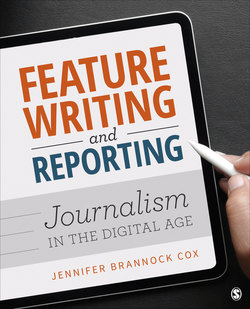Читать книгу Feature Writing and Reporting - Jennifer Brannock Cox - Страница 23
На сайте Литреса книга снята с продажи.
Words With Pros Changes to Feature Storytelling in the Digital Age
ОглавлениеInterview with Michael Kilian, Executive Editor, Democrat and Chronicle, Rochester, New York
Courtesy of Michael Kilian
Michael Kilian has seen some changes during his 40 years working in newspapers and magazines, but none quite as impactful as the mobile device.
“It was a much more disruptive force than desktop computers were. We know what readers consume online, and we know that we’re not only competing with other media. Now we’re competing with our daughter’s texts, YouTube videos, Twitter, Instagram—everything your phone can do.”
After working as a reporter and copy editor, Kilian transitioned into newsroom management roles in 1990. Through stints as executive editor for the Daily Times in Salisbury, Maryland; news director for the Cincinnati Enquirer; executive editor of the Burlington Free Press in Vermont; and now executive editor of the Democrat and Chronicle in Upstate New York, Kilian has guided reporters toward new storytelling strategies for engaging audiences.
“You have to think about what has value for the audience. What interests do they have? What needs to they have? We need to find ways to fill those readers’ needs. Why and how are key questions we have to answer in the stories we choose to pursue.”
Kilian says news organizations cannot compete internationally or even nationally the way they used to. Readers often get breaking news stories of worldwide importance from social media rather than their local newspaper. That’s why, he says, listening to the needs of the people in the community and crafting stories around them is the best way to make an impact.
“We usually learn about the what in a tweet, but the why and how keep us visiting stories for days and weeks and months after that. What do people really want to talk about? That’s the type of thing that breaks through the digital din on our phones.”
Under his direction, Kilian’s newsrooms have experimented with deep dives into immersive storytelling. In Cincinnati, sports reporters followed a minor league baseball player on his journey toward the major leagues, chronicling his story for six months through podcasts. Kilian’s Cincinnati team also spent a year in the city’s poorest schools, producing gripping news features from inside their walls.
In Maryland, Kilian encouraged his reporters to immerse themselves in their stories, sending them into the community to eat muskrat, a local “favorite”; to learn to surf in both sunny and snowy conditions; and to tag birds on the Chesapeake Bay with research experts.
“We can no longer be the detached voice of God where we’re observing the community rather than living in it. Stories like these had orders of magnitude higher than anything we did that year, and they made an impact because they gripped you.”
In the Digital Age, Kilian says, building loyalty to one publication is more challenging. Using innovative storytelling techniques to tell good stories on a daily basis can prompt subscribers to download and view a news organization’s app regularly, but creating that relationship is a longer process.
“We’re really living and dying one story at a time. To somebody on a phone, there isn’t a package of news that they make an appointment with every day. Whoever has the best story of the day will get read. Good storytelling is a wonderful way to be memorable.”
For aspiring journalists, Kilian encourages them to simply be human and answer the big, meaningful questions without getting bogged down in details.
“Readers don’t follow the process of government. They don’t need 37 stories on the process of a trash facility approval. You need to think: Can I do one larger story on what the plan for this trash facility tells us about our way of life? Whatever that story is, that’s the winner.”
